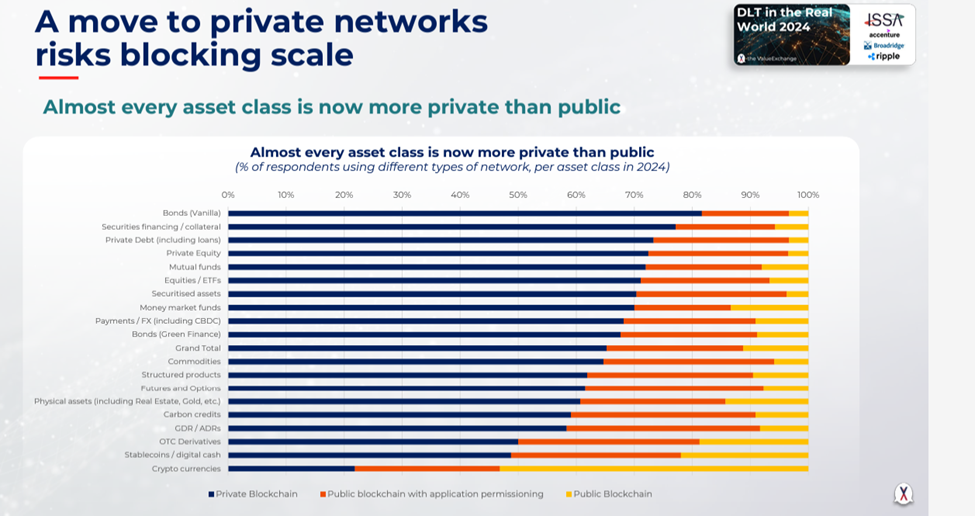News
La blockchain pubblica porta benefici alle industrie regolamentate

I settori regolamentati, tra cui sanità e servizi finanziari, devono rispettare numerosi requisiti, come know your customer (KYC), antiriciclaggio (AML) e normative sulla privacy dei dati. Per molti versi, la blockchain è la risposta alle liste dei desideri di questi settori. La blockchain consente robuste KYC e AML verificando le identità in tempo reale e fornendo un registro immutabile di dati e transazioni per il rilevamento di reati finanziari. Facilita inoltre la sicurezza Condivisione dei dati tra parti autorizzate tramite crittografia e controlli di accesso. Infine, gli smart contract su blockchain possono far rispettare le regole automaticamente, favorendo la conformità e riducendo l’errore umano.
Una domanda che si pone alle imprese regolamentate, tuttavia, è se sia preferibile una blockchain pubblica o privata per queste istituzioni. In effetti, l’opinione passata ha talvolta consigliato una blockchain privata e autorizzata per tali casi d’uso per garantire la massima privacy e protezione dei dati, tuttavia le catene private presentano una serie di sfide che possono vanificare i loro vantaggi. Ci sono sostenitori da entrambe le parti, ma le recenti innovazioni sulla blockchain pubblica, che offrono tutte le funzionalità di sicurezza delle catene private più i numerosi vantaggi delle catene pubbliche, potrebbero presto rendere questa domanda obsoleta.
I settori regolamentati offrono un terreno fertile per la blockchain
La tecnologia blockchain offre numerosi potenziali vantaggi per soddisfare le esigenze specifiche dei settori regolamentati, tra cui finanza, assistenza sanitaria, verifica dell’identità e gestione della supply chain, per citarne alcuni.
$19,7 miliardi Valore stimato del mercato della tecnologia blockchain in 2024
$943 miliardi Valore stimato del mercato della tecnologia blockchain in 2032
30%
La tecnologia Blockchain offre soluzioni eleganti alle sfide che devono affrontare i settori regolamentati.
Settori regolamentati presentano sfide speciali che la blockchain è idealmente attrezzata per gestire. In generale, esistono normative per offrire protezione ai partecipanti del settore, in genere in merito ai dati o al movimento di denaro. La trasparenza e la tracciabilità della blockchain hanno la capacità di aumentare la fiducia e la sicurezza, aumentando al contempo la velocità e l’efficienza delle operazioni.
Ad esempio, nell’assistenza sanitaria, la tecnologia di registro distribuito della blockchain può essere sfruttata per semplificare la centralizzazione delle cartelle cliniche dei pazienti, garantendo al contempo che solo le parti autorizzate abbiano accesso ai loro dati riservati. La blockchain offre inoltre ai servizi finanziari maggiore velocità e sicurezza delle transazioni, nonché l’eliminazione di costosi intermediari, come nel caso di pagamenti transfrontalieriLa tecnologia facilita transazioni più rapide ed efficienti rispetto ai metodi bancari tradizionali e la sua programmabilità tramite contratti intelligenti consente transazioni automatizzate e conformità normativa.
La blockchain sta diventando un elemento costante nella finanza.
Con l’espansione dell’economia digitale, la necessità di una forma di denaro digitale stabile, efficiente e sicura sta diventando sempre più evidente. Entrambi monete stabili E depositare token — rappresentazioni digitali di depositi bancari tradizionali emessi da istituzioni finanziarie regolamentate — stanno guadagnando consensi per questo scopo. A differenza delle criptovalute come Bitcoin o Ethereum, che sono spesso soggette a volatilità, sia le stablecoin che i token di deposito sono supportati da valuta fiat, il che li rende stabili come il denaro tradizionale o i depositi bancari. Alcune delle più grandi banche ritengono che gli asset tokenizzati siano cruciali per il futuro del panorama globale della moneta digitale.
Casi d’uso della blockchain per i settori regolamentati
Protezione dei dati sanitari:
La tecnologia blockchain può facilitare la condivisione sicura dei dati sanitari tra pazienti e fornitori, preservando al contempo la privacy e l’integrità dei dati.
Verifica dell’identità:
La tecnologia blockchain può offrire una verifica dell’identità decentralizzata, consentendo agli individui di condividere in modo sicuro le proprie informazioni personali senza dover ricorrere a provider di identità.
Contratti intelligenti:
I contratti autoeseguibili, o contratti intelligenti, possono far rispettare automaticamente i termini contrattuali, evitando la necessità di un’autorità centrale e determinando una riduzione dei costi e una maggiore efficienza.
Gestione della catena di approvvigionamento:
La blockchain può essere utilizzata per tracciare e verificare i beni mentre si spostano attraverso le diverse fasi di una supply chain. Ciò porta a una maggiore trasparenza, a una minore incidenza di frodi e a un approvvigionamento più etico.
Blockchain pubblica vs. privata per le industrie regolamentate
In passato, i preconcetti favorivano la blockchain privata rispetto a quella pubblica per i settori regolamentati, a causa dei severi requisiti sulla privacy dei dati, ma la blockchain privata presenta degli svantaggi che possono renderla insostenibile, oltre che meno sicura delle catene pubbliche.

Fonte: The Value Exchange. Risultati principali dell’indagine DLT nel mondo reale. 2024. https://www.broadridge.com/article/capital-markets/dlt-in-the-real-world-2024Ultimo accesso luglio 2024.
I vantaggi della blockchain privata per i settori normativi sono oggetto di dibattito.
La domanda inevitabile che si pone più frequentemente alle imprese regolamentate che stanno valutando l’ingresso nella blockchain è se le catene pubbliche o private siano più adatte ai loro scopi.
Blockchain private sono reti autorizzate in cui l’accesso è limitato ai partecipanti a cui è stato concesso il permesso di unirsi, con il processo di consenso generalmente controllato da una singola organizzazione o consorzio. Poiché il pubblico in generale non ha accesso al codice che abilita la rete, i sostenitori sostengono che blockchain privata è il candidato migliore per facilitare le transazioni aziendali regolamentate. In effetti, la pressione normativa ha portato a quasi due terzi delle ecosistema blockchain aziendale costituito da blockchain private. Tuttavia, ciò che questi argomenti non considerano è che la blockchain pubblica è in realtà molto sicura, e ci sono svantaggi all’utilizzo di catene private che possono renderle insostenibili o addirittura inutilizzabili.
La blockchain privata presenta degli svantaggi fondamentali rispetto alla blockchain pubblica.
Alcuni dei svantaggi della blockchain privata per le imprese includono quanto segue:
Costo alto: Stabilire e mantenere una rete blockchain privata può essere estremamente costoso, richiedendo un elevato numero di risorse relative a infrastruttura, sviluppo e costi operativi continui. In effetti, alcune fonti sostengono che le blockchain private sono, in sostanza, “database ingombranti,” con i costi dei server, del personale e dell’infrastruttura di rete che ricadono tutti sulla responsabilità dell’entità controllante. Questi costi spesso rendono le reti blockchain private impraticabili o insostenibili nel tempo, non solo per le aziende di medie e piccole dimensioni, ma anche per le principali aziende globali come IBM.
Difficoltà di scalabilità e interoperabilità: Le blockchain private possono incontrare problemi di scalabilità man mano che aumentano in dimensioni e complessità, soprattutto se la tecnologia sottostante non riesce a gestire adeguatamente un grande volume di informazioni. Una fonte nota che la blockchain privata è sostanzialmente Più lentamente e meno scalabile della blockchain pubblica. Inoltre, poiché le catene private sono generalmente costruite su tecnologie proprietariel’interoperabilità tra numerose istituzioni è spesso impossibile da realizzare, con costi che la rendono impraticabile per la maggior parte dei proprietari privati.
Problemi di sicurezza: La sicurezza di una blockchain privata dipende in larga misura dal meccanismo di consenso scelto e dall’affidabilità dei partecipanti. Un partecipante malintenzionato o compromesso potrebbe corrompere l’intera rete. Ironicamente, alcuni sostengono persino che la natura esclusiva delle blockchain private può renderle più vulnerabile ai cattivi attori rispetto alle reti pubbliche. Analogamente, la mancanza di trasparenza delle blockchain private attraverso la restrizione ai partecipanti autorizzati può, nel peggiore dei casi, aumentare il potenziale di manipolazione dei dati.
Blockchain pubblica: nuove funzionalità per i settori regolamentati
La blockchain pubblica è veloce, poco costosa e, in ultima analisi, molto sicura. Inoltre, le estensioni token innovative stanno portando tutti i vantaggi delle reti private e autorizzate alla blockchain pubblica.
I vantaggi della blockchain pubblica includono gli stessi vantaggi della blockchain privata e molto altro ancora.
Le blockchain pubbliche sono costituite da reti decentralizzate che consentono a chiunque di partecipare, visualizzare la cronologia delle transazioni e verificare l’integrità dei dati tramite un meccanismo di consenso, come la “prova di lavoro” su Bitcoin o la “prova di partecipazione” su reti come Ethereum o Solana. I proponenti della blockchain pubblica aggiunge anche che, contrariamente al suo nome, è molto privata. Infatti, nella sua forma originale ideazione e progettazionela sicurezza intrinseca della blockchain deriva dall’anonimato delle parti coinvolte in una determinata transazione. Il record immutabile e permanente delle transazioni della blockchain garantisce questa sicurezza e, poiché questo record viene rapidamente convalidato da più data center indipendenti in tutto il mondo, il consenso è rapido, escludendo quasi completamente la manomissione dei dati. Inoltre, la crittografia integrata e altre forme di offuscamento migliorano ulteriormente il principio di sicurezza innato della blockchain pubblica.
Su Solana, le estensioni dei token stanno aprendo nuovi casi d’uso sulla blockchain pubblica.
Inoltre, le innovazioni nella blockchain pubblica stanno rendendo irrilevante lo stesso dibattito pubblico contro privato. Estensioni tokenun nuovo programma di emissione di token, ad esempio, è un’innovazione chiavi in mano sulla blockchain pubblica di Solana che può applicare controlli di sicurezza alla rete simili a quelli delle blockchain private autorizzate. Alcune delle funzionalità abilitate da queste “estensioni” includono trasferimenti riservati, reversibilità e la possibilità di inserire account in whitelist o blacklist a livello globale. Poiché queste funzionalità sono integrate nel token stesso, non c’è bisogno di smart contract di terze parti per abilitare questo tipo di funzionalità. Questa innovazione sta attualmente rendendo possibili nuovi casi d’uso sulla blockchain pubblica per le imprese regolamentate, come l’emissione di stablecoin per i pagamenti e la tokenizzazione di beni del mondo realecomprese azioni, obbligazioni, immobiliarematerie prime e persino opere d’arte. La tokenizzazione di questi asset consente una maggiore liquidità e una proprietà frazionata, rendendo questi investimenti più accessibili a coloro che altrimenti non potrebbero prendere parte a queste opportunità.
Si sta verificando un “cambiamento di slancio” tra le aziende verso l’adozione della blockchain pubblica.
Un rapporto di HFS Horizons ha notato un recente “cambiamento di slancio come attenzione all’impresa virato verso blockchain pubbliche”, con l’innovazione in corso che guida un’ulteriore crescita nella loro adozione da parte delle imprese regolamentate. I ricercatori hanno notato che mentre le imprese altamente regolamentate hanno spesso segnalato di scegliere blockchain private a causa della pressione normativa, le aziende stanno diventando sempre più a loro agio con blockchain pubbliche poiché l’innovazione sblocca nuovi livelli di privacy. Il rapporto conclude che le imprese si rivolgeranno sempre di più a blockchain pubbliche per raggiungere la scalabilità negli anni a venire.
Soluzioni blockchain pubbliche sicure e stabili per i settori regolamentati
Innovazioni come le estensioni token della rete Solana sono indicative di un cambiamento di paradigma nel modo in cui gli asset vengono sviluppati, gestiti e scambiati. Rafforzando le misure di sicurezza, garantendo la conformità normativa e incoraggiando la tokenizzazione degli asset del mondo reale, questa innovazione potrebbe consentire alla blockchain di rivoluzionare una serie di settori regolamentati.
Poiché l’integrazione della blockchain continua a colmare il divario tra gli ecosistemi finanziari tradizionali e quelli decentralizzati, questa tecnologia può contribuire ad aprire la strada a un’economia globale più efficiente, basata su trasparenza, sicurezza e inclusione finanziaria.
Diversi fattori hanno contribuito a Solana che viene scelto per la [PayPal USD (PYUSD)] espansione, tra cui la comprovata convenienza economica e l’elevata produttività. Tuttavia, la ragione più sfumata per la scelta di Solana è legata alle caratteristiche uniche che abilita per PYUSD. PYUSD è abilitato dalle estensioni token Solana, che portano le familiari caratteristiche FinTech ai pagamenti stablecoin. Queste caratteristiche non sono semplicemente optional. Riteniamo che siano caratteristiche importanti da fornire ai commercianti se PYUSD deve crescere nella sua utilità per segmenti commerciali più ampi.”
Fonte: PayPal USD. PYUSD viene lanciato su Solana: la prossima fase di adozione. 29 maggio 2024. https://pyusd.mirror.xyz/TpEwPNybrwzPSSQenLtO4kggy98KH4oQRc06ggVnA0kUltimo accesso luglio 2024.
News
Terra Can’t Catch a Break as Blockchain Gets $6 Million Exploited

The attack, which exploited a vulnerability disclosed in April, drained around 60 million ASTRO tokens, sending the price plummeting.
The Terra blockchain has been exploited for over $6 million, forcing developers to take a momentary break the chain.
Beosin Cyber Security Company reported that the protocol lost 60 million ASTRO tokens, 3.5 million USDC, 500,000 USDT, and 2.7 BTC or $180,000.
Terra developers paused the chain on Wednesday morning to apply an emergency patch that would address the attack. Moments later, a 67% majority of validators upgraded their nodes and resumed block production.
The ASTRO token has plunged as much as 75%. It is now trading at $0.03, a 25% decline on the day. Traders who took advantage of the drop are now on 195%.
The vulnerability that took down the Cosmos-based blockchain was disclosed in April and involved the deployment of a malicious CosmWasm contract. It opened the door to attacks via what is called an “ibc-hooks callback timeout reentrancy vulnerability,” which is used to invoke contracts and enable cross-chain swaps.
Terra 2.0 also suffered a massive drop in total value locked (TVL) in April, shortly after the vulnerability was discovered. It plunged 80% to $6 million from $30 million in TVL and has since lost nearly half of that value, currently sitting at $3.9 million.
The current Earth chain emerged from the rubble as a hard fork after the original blockchain, now called Terra Classic, collapsed in 2022. Terra collapsed after its algorithmic stablecoin (UST) lost its peg, causing a run on deposits. More than $50 billion of UST’s market cap was wiped out in a matter of days.
Terraform Labs, the company behind the blockchain, has been slowly unravelling its legal woes since its mid-2022 crash. Founder Do Kwon awaits sentencing in Montenegro after he and his company were found liable for $40 billion in customer funds in early April.
On June 12, Terraform Labs settled with the SEC for $4.4 billion, for which the company will pay about $3.59 billion plus interest and a $420 million penalty. Meanwhile, Kwon will pay $204.3 million, including $110 million in restitution, interest and an $80 million penalty, a court filing showed.
News
Google and Coinbase Veterans Raise $5M to Build Icebreaker, Blockchain’s Answer to LinkedIn

Icebreaker: Think LinkedIn but on a Blockchain—announced Wednesday that it has secured $5 million in seed funding. CoinFund led the round, with participation from Accomplice, Anagram, and Legion Capital, among others.
The company, which is valued at $21 million, aims to become the world’s first open-source network for professional connections. Its co-founders, Dan Stone and Jack Dillé, come from Google AND Monetary base; Stone was a product manager at the cryptocurrency giant and also the co-creator of Google’s largest multi-identity measurement and marketing platform, while Dillé was a design manager for Google Working area.

The pair founded Icebreaker on the shared belief that the imprint of one’s digital identity (and reputation) should not be owned by a single entity, but rather publicly owned and accessible to all. Frustrated that platforms like LinkedIn To limit how we leverage our connections, Dillé told Fortune he hopes to remove paywalls and credits, which “force us to pay just to browse our network.” Using blockchain technology, Icebreaker lets users transfer their existing professional profile and network into a single, verified channel.
“Imagine clicking the login button and then seeing your entire network on LinkedIn, ChirpingFarcaster and email? Imagine how many introductions could be routed more effectively if you could see the full picture of how you’re connected to someone,” Stone told Fortune.
Users can instantly prove their credentials and provide verifiable endorsements for people in their network. The idea is to create an “open graph of reputation and identity,” according to the founders. They hope to challenge LinkedIn’s closed network that “secures data,” freeing users to search for candidates and opportunities wherever they are online. By building on-chain, the founders note, they will create a public ledger of shared context and trust.
Verified channels are now launched for
Chirping
Online Guide
Wallet
Discord
Telephone
TeleporterYou can find them in Account -> Linked Accounts Italian: https://t.co/mRDyuWW8O2
— Icebreaker (@icebreaker_xyz) April 3, 2024
“Digital networking is increasingly saturated with noise and AI-driven fake personas,” the founders said in a statement. For example: Dillé’s LinkedIn headline reads “CEO of Google,” a small piece of digital performance art to draw attention to unverifiable information on Web2 social networks that can leave both candidates and recruiters vulnerable to false claims.
“Icebreaker was created to enable professionals to seamlessly tap into their existing profiles and networks to surface exceptional people and opportunities, using recent advances in cryptographically verifiable identity,” the company said, adding that the new funding will go towards expanding its team and developing products.
“One of the next significant use cases for cryptocurrency is the development of fundamental social graphs for applications to leverage… We are proud to support Dan, Jack and their team in their mission to bring true professional identity ownership to everyone online,” said CoinFund CIO Alex Felix in a statement.
Learn more about all things cryptocurrency with short, easy-to-read flashcards. Click here to Fortune’s Crash Course in Cryptocurrency.
Fuente
News
Luxembourg proposes updates to blockchain laws | Insights and resources

On July 24, 2024, the Ministry of Finance proposed Blockchain Bill IVwhich will provide greater flexibility and legal certainty for issuers using Distributed Ledger Technology (DLT). The bill will update three of Luxembourg’s financial laws, the Law of 6 April 2013 on dematerialised securitiesTHE Law of 5 April 1993 on the financial sector and the Law of 23 December 1998 establishing a financial sector supervisory commissionThis bill includes the additional option of a supervisory agent role and the inclusion of equity securities in dematerialized form.
DLT and Luxembourg
DLT is increasingly used in the financial and fund management sector in Luxembourg, offering numerous benefits and transforming various aspects of the industry.
Here are some examples:
- Digital Bonds: Luxembourg has seen multiple digital bond issuances via DLT. For example, the European Investment Bank has issued bonds that are registered, transferred and stored via DLT processes. These bonds are governed by Luxembourg law and registered on proprietary DLT platforms.
- Fund Administration: DLT can streamline fund administration processes, offering new opportunities and efficiencies for intermediaries, and can do the following:
- Automate capital calls and distributions using smart contracts,
- Simplify audits and ensure reporting accuracy through transparent and immutable transaction records.
- Warranty Management: Luxembourg-based DLT platforms allow clients to swap ownership of baskets of securities between different collateral pools at precise times.
- Tokenization: DLT is used to tokenize various assets, including real estate and luxury goods, by representing them in a tokenized and fractionalized format on the blockchain. This process can improve the liquidity and accessibility of traditionally illiquid assets.
- Tokenization of investment funds: DLT is being explored for the tokenization of investment funds, which can streamline the supply chain, reduce costs, and enable faster transactions. DLT can automate various elements of the supply chain, reducing the need for reconciliations between entities such as custodians, administrators, and investment managers.
- Issuance, settlement and payment platforms:Market participants are developing trusted networks using DLT technology to serve as a single source of shared truth among participants in financial instrument investment ecosystems.
- Legal framework: Luxembourg has adapted its legal framework to accommodate DLT, recognising the validity and enforceability of DLT-based financial instruments. This includes the following:
- Allow the use of DLT for the issuance of dematerialized securities,
- Recognize DLT for the circulation of securities,
- Enabling financial collateral arrangements on DLT financial instruments.
- Regulatory compliance: DLT can improve transparency in fund share ownership and regulatory compliance, providing fund managers with new opportunities for liquidity management and operational efficiency.
- Financial inclusion: By leveraging DLT, Luxembourg aims to promote greater financial inclusion and participation, potentially creating a more diverse and resilient financial system.
- Governance and ethics:The implementation of DLT can promote higher standards of governance and ethics, contributing to a more sustainable and responsible financial sector.
Luxembourg’s approach to DLT in finance and fund management is characterised by a principle of technology neutrality, recognising that innovative processes and technologies can contribute to improving financial services. This is exemplified by its commitment to creating a compatible legal and regulatory framework.
Short story
Luxembourg has already enacted three major blockchain-related laws, often referred to as Blockchain I, II and III.
Blockchain Law I (2019): This law, passed on March 1, 2019, was one of the first in the EU to recognize blockchain as equivalent to traditional transactions. It allowed the use of DLT for account registration, transfer, and materialization of securities.
Blockchain Law II (2021): Enacted on 22 January 2021, this law strengthened the Luxembourg legal framework on dematerialised securities. It recognised the possibility of using secure electronic registration mechanisms to issue such securities and expanded access for all credit institutions and investment firms.
Blockchain Act III (2023): Also known as Bill 8055, this is the most recent law in the blockchain field and was passed on March 14, 2023. This law has integrated the Luxembourg DLT framework in the following way:
- Update of the Act of 5 August 2005 on provisions relating to financial collateral to enable the use of electronic DLT as collateral on financial instruments registered in securities accounts,
- Implementation of EU Regulation 2022/858 on a pilot scheme for DLT-based market infrastructures (DLT Pilot Regulation),
- Redefining the notion of financial instruments in Law of 5 April 1993 on the financial sector and the Law of 30 May 2018 on financial instruments markets to align with the corresponding European regulations, including MiFID.
The Blockchain III Act strengthened the collateral rules for digital assets and aimed to increase legal certainty by allowing securities accounts on DLT to be pledged, while maintaining the efficient system of the 2005 Act on Financial Collateral Arrangements.
With the Blockchain IV bill, Luxembourg will build on the foundations laid by previous Blockchain laws and aims to consolidate Luxembourg’s position as a leading hub for financial innovation in Europe.
Blockchain Bill IV
The key provisions of the Blockchain IV bill include the following:
- Expanded scope: The bill expands the Luxembourg DLT legal framework to include equity securities in addition to debt securities. This expansion will allow the fund industry and transfer agents to use DLT to manage registers of shares and units, as well as to process fund shares.
- New role of the control agent: The bill introduces the role of a control agent as an alternative to the central account custodian for the issuance of dematerialised securities via DLT. This control agent can be an EU investment firm or a credit institution chosen by the issuer. This new role does not replace the current central account custodian, but, like all other roles, it must be notified to the Commission de Surveillance du Secteur Financier (CSSF), which is designated as the competent supervisory authority. The notification must be submitted two months after the control agent starts its activities.
- Responsibilities of the control agent: The control agent will manage the securities issuance account, verify the consistency between the securities issued and those registered on the DLT network, and supervise the chain of custody of the securities at the account holder and investor level.
- Simplified payment processesThe bill allows issuers to meet payment obligations under securities (such as interest, dividends or repayments) as soon as they have paid the relevant amounts to the paying agent, settlement agent or central account custodian.
- Simplified issuance and reconciliationThe bill simplifies the process of issuing, holding and reconciling dematerialized securities through DLT, eliminating the need for a central custodian to have a second level of custody and allowing securities to be credited directly to the accounts of investors or their delegates.
- Smart Contract Integration:The new processes can be executed using smart contracts with the assistance of the control agent, potentially increasing efficiency and reducing intermediation.
These changes are expected to bring several benefits to the Luxembourg financial sector, including:
- Fund Operations: Greater efficiency and reduced costs by leveraging DLT for the issuance and transfer of fund shares.
- Financial transactions: Greater transparency and security.
- Transparency of the regulatory environment: Increased attractiveness and competitiveness of the Luxembourg financial centre through greater legal clarity and flexibility for issuers and investors using DLT.
- Smart Contracts: Potential for automation of contractual terms, reduction of intermediaries and improvement of transaction traceability through smart contracts.
Blockchain Bill IV is part of Luxembourg’s ongoing strategy to develop a strong digital ecosystem as part of its economy and maintain its status as a leading hub for financial innovation. Luxembourg is positioning itself at the forefront of Europe’s growing digital financial landscape by constantly updating its regulatory framework.
Local regulations, such as Luxembourg law, complement European regulations by providing a more specific legal framework, adapted to local specificities. These local laws, together with European initiatives, aim to improve both the use and the security of projects involving new technologies. They help establish clear standards and promote consumer trust, while promoting innovation and ensuring better protection against potential risks associated with these emerging technologies. Check out our latest posts on these topics and, for more information on this law, blockchain technology and the tokenization mechanism, do not hesitate to contact us.
We are available to discuss any project related to digital finance, cryptocurrencies and disruptive technologies.
This informational piece, which may be considered advertising under the ethics rules of some jurisdictions, is provided with the understanding that it does not constitute the rendering of legal or other professional advice by Goodwin or its attorneys. Past results do not guarantee a similar outcome.
News
New bill pushes Department of Veterans Affairs to examine how blockchain can improve its work

The Department of Veterans Affairs would have to evaluate how blockchain technology could be used to improve benefits and services offered to veterans, according to a legislative proposal introduced Tuesday.
The bill, sponsored by Rep. Nancy Mace, R-S.C., would direct the VA to “conduct a comprehensive study of the feasibility, potential benefits, and risks associated with using distributed ledger technology in various programs and services.”
Distributed ledger technology, including blockchain, is used to protect and track information by storing data across multiple computers and keeping a record of its use.
According to the text of the legislation, which Mace’s office shared exclusively with Nextgov/FCW ahead of its publication, blockchain “could significantly improve benefits allocation, insurance program management, and recordkeeping within the Department of Veterans Affairs.”
“We need to bring the federal government into the 21st century,” Mace said in a statement. “This bill will open the door to research on improving outdated systems that fail our veterans because we owe it to them to use every tool at our disposal to improve their lives.”
Within one year of the law taking effect, the Department of Veterans Affairs will be required to submit a report to the House and Senate Veterans Affairs committees detailing its findings, as well as the benefits and risks identified in using the technology.
The mandatory review is expected to include information on how the department’s use of blockchain could improve the way benefits decisions are administered, improve the management and security of veterans’ personal data, streamline the insurance claims process, and “increase transparency and accountability in service delivery.”
The Department of Veterans Affairs has been studying the potential benefits of using distributed ledger technology, with the department emission a request for information in November 2021 seeking input from contractors on how blockchain could be leveraged, in part, to streamline its supply chains and “secure data sharing between institutions.”
The VA’s National Institute of Artificial Intelligence has also valued the use of blockchain, with three of the use cases tested during the 2021 AI tech sprint focused on examining its capabilities.
Mace previously introduced a May bill that would direct Customs and Border Protection to create a public blockchain platform to store and share data collected at U.S. borders.
Lawmakers also proposed additional measures that would push the Department of Veterans Affairs to consider adopting other modernized technologies to improve veteran services.
Rep. David Valadao, R-Calif., introduced legislation in June that would have directed the department to report to lawmakers on how it plans to expand the use of “certain automation tools” to process veterans’ claims. The House of Representatives Subcommittee on Disability Assistance and Memorial Affairs gave a favorable hearing on the congressman’s bill during a Markup of July 23.
-

 Videos12 months ago
Videos12 months agoCrypto News: Bitcoin, ETH Price, CPI Print, PYTH, WIF & MORE!!
-

 Videos11 months ago
Videos11 months agoCrypto News: Bitcoin Price, ETF, ETH, WIF, HNT & MORE!!
-

 DeFi11 months ago
DeFi11 months agoMetasphere Labs announces follow-up event regarding
-

 Videos12 months ago
Videos12 months agoSolana price potential?! Check out THIS update if you own SOL!!
-

 DeFi8 months ago
DeFi8 months agoPump.Fun Overtakes Ethereum in Daily Revenue: A New Leader in DeFi
-

 News8 months ago
News8 months agoNew bill pushes Department of Veterans Affairs to examine how blockchain can improve its work
-

 DeFi8 months ago
DeFi8 months agoDegens Can Now Create Memecoins From Tweets
-

 News8 months ago
News8 months agoLawmakers, regulators to study impact of blockchain and cryptocurrency in Alabama • Alabama Reflector
-

 Bitcoin8 months ago
Bitcoin8 months ago1 Top Cryptocurrency That Could Surge Over 4,300%, According to This Wall Street Firm
-

 Videos11 months ago
Videos11 months agoWho Really CONTROLS THE MARKETS!! Her plans REVEALED!!
-

 Ethereum11 months ago
Ethereum11 months agoComment deux frères auraient dérobé 25 millions de dollars lors d’un braquage d’Ethereum de 12 secondes • The Register
-

 Videos11 months ago
Videos11 months agoCryptocurrency News: BTC Rally, ETH, SOL, FTM, USDT Recover & MORE!

 ASTRO Price
ASTRO Price



